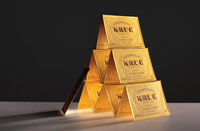 The most expensive wine at the LCBO is Krug’s 1995 Clos D’Ambonnay Champagne ($3,494.90, Vintages #91827). I’ve never paid four figures for a wine, but I suppose I’ve done my best to overindulge.
The most expensive wine at the LCBO is Krug’s 1995 Clos D’Ambonnay Champagne ($3,494.90, Vintages #91827). I’ve never paid four figures for a wine, but I suppose I’ve done my best to overindulge.
The most expensive wine at the LCBO is Krug’s 1995 Clos D’Ambonnay Champagne ($4,529 Now: $1,000, Vintages #91827). I’ve never paid four figures for a wine, but I suppose I’ve done my best to overindulge. My ex-wife once castigated me publicly (well, on her blog) after I mentioned to her that I had opened a $400 bottle. She wrote that this proved I was nothing but a popinjay. Just to rub it in, several of her friends added chirpy online comments enlarging upon my moral bankruptcy: one exclaimed that drinking forty $10 bottles would’ve been a less neurotic use of 400 bucks.
Naturally, this hurt. I may be a morally bankrupt popinjay — but saying that expensive wine is a waste of money is a slander that I just can’t bear. Ex-Sullivan et cronies, expect a notice from my solicitors!
To truly appreciate the art of viniculture, you have to be ready to pay as much for a bottle as you would for opera seats or Leafs tickets. Unlike cheaper wines, expensive bottles usually come from small wineries that try to capture the unique flavour of a select piece of land. They don’t enjoy the benefits of economies of scale — and they can’t bargain for their grapes. Furthermore, they use onerous techniques to produce a better product: removing the stems by hand, for instance, makes the wine smoother, while pressing the grapes manually intensifies flavours. The results are idiosyncratic wonders whose value transcends price.
Of course, many expensive wines are mediocre, not unlike many expensive lawyers. For example, at the time of writing, the second-priciest wine at the LCBO was a Double Magnum of 1995 Chateau Mouton Rothschild ($4,145, Vintages #689281). Although many critics go slack-jawed for Mouton, I sampled it at a blind tasting and found it underwhelming: lean and brittle. Perhaps 400 bottles of Yellow Tail would be a better way to spend your money.
Into the Short Cellar
Penfolds 2006 Yattarna Chardonnay
$115, Australia, Vintages Classics Catalogue #558643 (as available)
Yattarna is Penfold’s flagship white and it may simply be the best Chardonnay that I’ve ever tasted. The nose is lusty, with notes of yogurt, mint and crème brûlée. The palate is as fresh as a tangerine and as ripe as a peach. Age for up to 12 years to deepen the flavours. 95/100
![]() Château De Beaucastel 2007 Châteauneuf-du-Pape
Château De Beaucastel 2007 Châteauneuf-du-Pape
$89.95, France, Vintages #711317
Château de Beaucastel is one of the world’s most prestigious wines, which means its $90 price tag makes it something of a bargain. Plus 2007 is celebrated as their best vintage in many years. But Beaucastel takes ages to mature, so hold until 2016-2024. Earthy and superb. 94/100
Don’t screw up
Before opening any expensive or old bottle, you must have a really good corkscrew
- Avoid old-style corkscrews where the helix resembles a solid drill bit. Old corks are often dry and fragile and this kind of corkscrew will pulverize them.
- I prefer the manual corkscrews that waiters use — the ones that look like a pocketknife.
- The best have a two-step brace that you lever against the bottle’s mouth. Your corkscrew’s helix should be a spiral “worm” with a hollow centre — these burrow into the cork without ripping it.
Matthew Sullivan is a civil litigator in Toronto. He blogs weekly here on lawandstyle.ca. The Short Cellar column also appears in the print edition of Precedent. Matthew can be reached at matthew@lawandstyle.beta-site.ca. Follow along on Twitter: @shortcellar.

